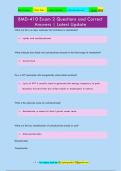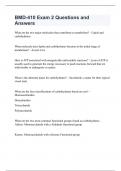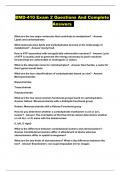Bmd 410 exam 2 - Study guides, Class notes & Summaries
Looking for the best study guides, study notes and summaries about Bmd 410 exam 2? On this page you'll find 4 study documents about Bmd 410 exam 2.
All 4 results
Sort by
BMD-410 Exam 2 Questions And Complete Answers ...

-
BMD-410 Exam 2 Questions and Correct Answers | Latest Update
- Exam (elaborations) • 46 pages • 2024
-
- $13.49
- + learn more
What are the two major molecules that contribute to metabolism? Lipids and carbohydrates What molecule does lipids and carbohydrates become in the initial stage of metabolism? Acetyl CoA How is ATP associated with energetically unfavorable reactions? Lysis of ATP is usually used to generate the energy necessary to push reactions forward that are unfavorable or endergonic in nature. What is the alternate name for carbohydrates? Saccharide, a name for their typical sweet t...

-
BMD-410 Exam 2 Questions and Answers
- Exam (elaborations) • 30 pages • 2024
- Available in package deal
-
- $13.49
- + learn more
What are the two major molecules that contribute to metabolism? - Lipids and carbohydrates What molecule does lipids and carbohydrates become in the initial stage of metabolism? - Acetyl CoA How is ATP associated with energetically unfavorable reactions? - Lysis of ATP is usually used to generate the energy necessary to push reactions forward that are unfavorable or endergonic in nature. What is the alternate name for carbohydrates? - Saccharide, a name for their typical sweet taste ...

-
BMD 410 Lecture 2 exam guide 2024
- Exam (elaborations) • 3 pages • 2024
- Available in package deal
-
- $13.99
- + learn more
Which bonds are important in biology? - Permanent bonds-covalent for backbones Transient bonds-hydrogen for structural changes What is the difference between covalent and non-covalent interactions? - Covalent bonds share electrons while noncovalent bonds don't share of electrons What are hydrophobic interactions? - Association or interactions of nonpolar molecules or components of molecules in aqueous solution -main driving force of -protein folding -protein protein interactions ...

Do you wonder why so many students wear nice clothes, have money to spare and enjoy tons of free time? Well, they sell on Stuvia! Imagine your study notes being downloaded a dozen times for $15 each. Every. Single. Day. Discover all about earning on Stuvia



